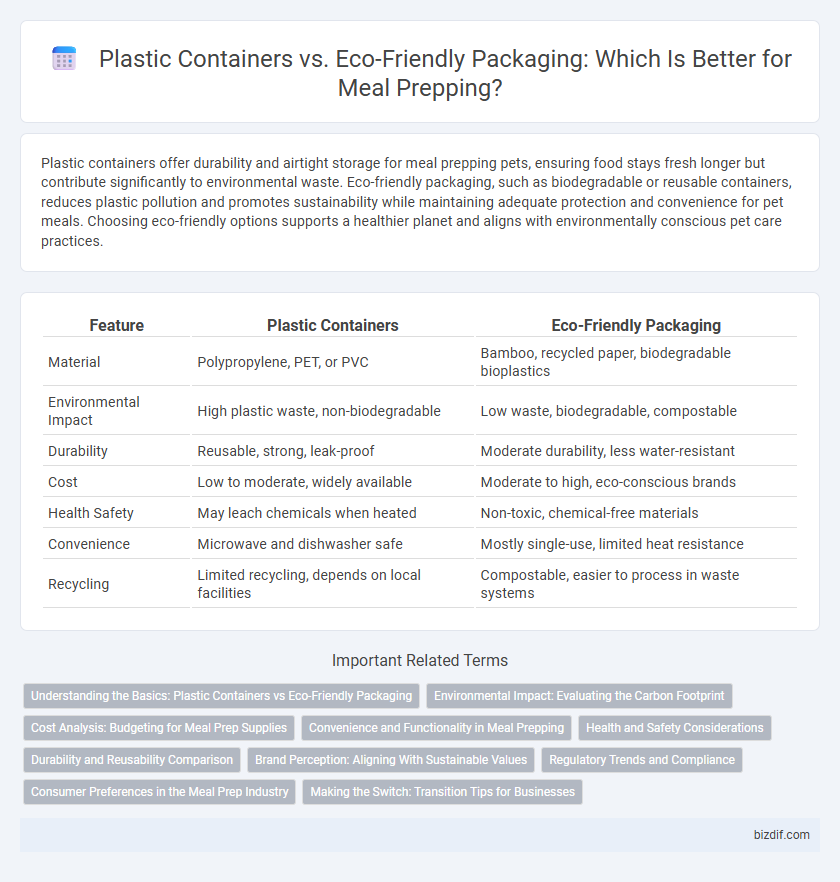Plastic containers offer durability and airtight storage for meal prepping pets, ensuring food stays fresh longer but contribute significantly to environmental waste. Eco-friendly packaging, such as biodegradable or reusable containers, reduces plastic pollution and promotes sustainability while maintaining adequate protection and convenience for pet meals. Choosing eco-friendly options supports a healthier planet and aligns with environmentally conscious pet care practices.
Table of Comparison
| Feature | Plastic Containers | Eco-Friendly Packaging |
|---|---|---|
| Material | Polypropylene, PET, or PVC | Bamboo, recycled paper, biodegradable bioplastics |
| Environmental Impact | High plastic waste, non-biodegradable | Low waste, biodegradable, compostable |
| Durability | Reusable, strong, leak-proof | Moderate durability, less water-resistant |
| Cost | Low to moderate, widely available | Moderate to high, eco-conscious brands |
| Health Safety | May leach chemicals when heated | Non-toxic, chemical-free materials |
| Convenience | Microwave and dishwasher safe | Mostly single-use, limited heat resistance |
| Recycling | Limited recycling, depends on local facilities | Compostable, easier to process in waste systems |
Understanding the Basics: Plastic Containers vs Eco-Friendly Packaging
Plastic containers offer durability, airtight seals, and convenience for meal prepping but contribute significantly to environmental pollution due to their non-biodegradable nature. Eco-friendly packaging options like biodegradable, compostable, or reusable materials reduce waste and toxicity, supporting sustainable meal storage and transport. Understanding the balance between functionality and environmental impact is essential for choosing packaging that aligns with health goals and ecological responsibility.
Environmental Impact: Evaluating the Carbon Footprint
Plastic containers contribute significantly to greenhouse gas emissions due to their production from fossil fuels and limited recyclability, resulting in a higher carbon footprint compared to eco-friendly packaging options. Eco-friendly packaging, often made from biodegradable materials like bamboo, cornstarch, or recycled paper, reduces environmental impact through compostability and lower energy consumption during manufacturing. Transitioning to sustainable meal prep containers not only minimizes waste in landfills but also promotes a circular economy by reducing reliance on virgin plastics and lowering overall carbon emissions.
Cost Analysis: Budgeting for Meal Prep Supplies
Plastic containers often have a lower upfront cost compared to eco-friendly packaging, making them a popular choice for budget-conscious meal preppers. However, eco-friendly options such as biodegradable containers or reusable glass jars may offer long-term savings by reducing waste disposal fees and promoting durability. Factoring in both initial expenses and sustainability benefits is essential for effective budgeting in meal prep supplies.
Convenience and Functionality in Meal Prepping
Plastic containers offer airtight seals and stackability, enhancing convenience and efficient storage during meal prepping. Eco-friendly packaging, such as biodegradable or reusable materials, prioritizes sustainability while maintaining functionality through leak-proof designs and microwave-safe properties. Choosing between the two depends on balancing durability, reusability, and environmental impact for long-term meal prep efficiency.
Health and Safety Considerations
Plastic containers used in meal prepping often contain BPA and phthalates, chemicals that can leach into food and pose health risks such as hormone disruption. Eco-friendly packaging made from materials like glass, stainless steel, or plant-based bioplastics eliminates exposure to these harmful substances while ensuring food safety. Choosing sustainable containers not only reduces environmental impact but also minimizes the potential for chemical contamination in stored meals.
Durability and Reusability Comparison
Plastic containers offer high durability and excellent resistance to impacts, making them ideal for repeated use and long-term storage of meal preps. Eco-friendly packaging, such as those made from bamboo or biodegradable materials, often provides moderate durability but excels in sustainability through compostability and reduced environmental impact. Choosing between the two depends on prioritizing long-lasting usability or environmental responsibility in meal prepping routines.
Brand Perception: Aligning With Sustainable Values
Plastic containers often convey convenience but can negatively impact brand perception due to environmental concerns. Eco-friendly packaging, made from biodegradable or recyclable materials, enhances brand image by aligning with growing consumer demand for sustainability. Brands prioritizing green packaging demonstrate commitment to environmental responsibility, fostering trust and loyalty among eco-conscious customers.
Regulatory Trends and Compliance
Regulatory trends increasingly favor eco-friendly packaging over traditional plastic containers due to stricter environmental compliance requirements aimed at reducing plastic waste and enhancing recyclability. Governments worldwide are implementing bans on single-use plastics and setting standards for biodegradable or compostable materials in meal prepping containers. Staying compliant involves adopting sustainable alternatives that meet these evolving regulations while maintaining food safety and durability.
Consumer Preferences in the Meal Prep Industry
Consumer preferences in the meal prep industry increasingly favor sustainable options, with a growing shift from traditional plastic containers to eco-friendly packaging made from biodegradable or compostable materials. Research indicates that 68% of meal prep customers prioritize environmental impact, influencing brands to adopt packaging solutions such as plant-based plastics or recycled paper products. This transition aligns with global trends in reducing plastic waste, enhancing brand loyalty, and meeting regulatory demands for sustainable food packaging.
Making the Switch: Transition Tips for Businesses
Transitioning from plastic containers to eco-friendly packaging in meal prepping businesses involves gradually introducing biodegradable or reusable materials like bamboo, glass, or compostable PLA. Educating customers on environmental benefits and offering incentives such as discounts for returning containers can boost acceptance and reduce waste. Streamlining supply chains to source sustainable packaging and investing in training for staff ensures a smooth operational shift while enhancing brand reputation.
Plastic Containers vs Eco-Friendly Packaging Infographic

 bizdif.com
bizdif.com